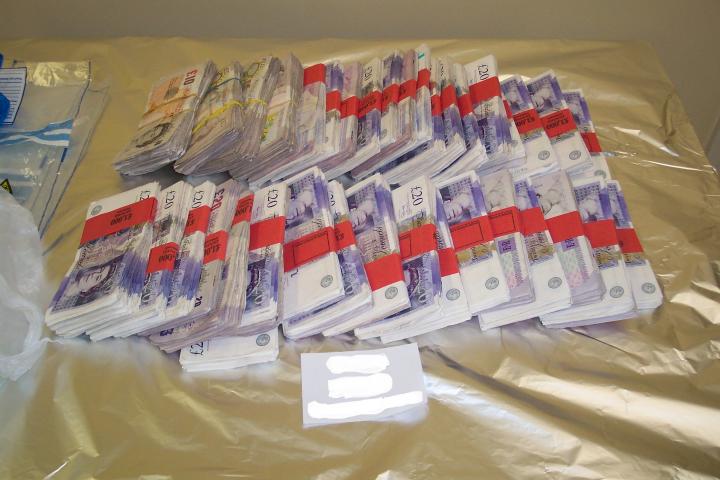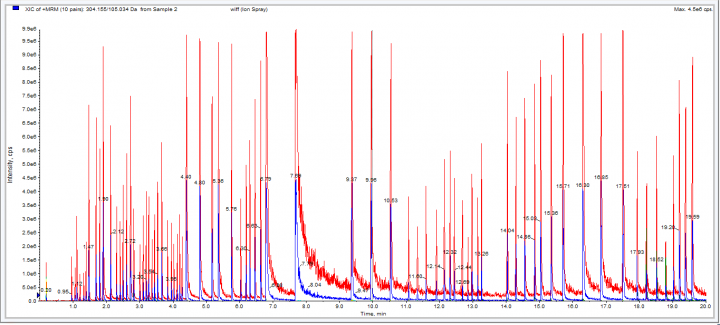Cocaine Crime Stats
Trace amounts of cocaine on banknotes can tell a surprisingly rich and telling story about the notes’ history, as Amy Wilson from the Centre for Statistics has found out.
It may come as a shock to hear that the £5 note your grandmother slipped in your birthday card years ago was likely tainted with cocaine. But this doesn’t mean she’s been moonlighting as an international crime lord. The majority of banknotes – from the £10 note in your wallet to the cash you withdrew from the ATM at the weekend – have traces of cocaine on them too.
With most notes tainted, the presence of cocaine on banknotes holds little value as criminal evidence. It is the quantity of cocaine from which a picture of the notes’ illicit or otherwise history starts to emerge. Yet quantity alone can also be misleading – context is crucial to assessing a note’s value as evidence, and many factors play a role. Teasing out whether cash is associated with drug dealing is not as straightforward as first impressions would suggest.

Weight of evidence
Amy Wilson is an applied statistician at the Centre for Statistics whose work aims to illuminate the value of using the quantity of cocaine on cash as evidence in criminal proceedings. Amy surprisingly started out as a pension actuary, but craved “flexibility and freedom in finding real-world solutions”. At a University of Edinburgh open day she found what she was looking for when she spoke to forensic statistician Colin Aitken. At the time, Colin had just been an expert witness for the defence in an appeal case about drugs on banknotes. In his study of the evidence, he had found problems with the prosecution’s statistics. “The forensic scientist on the other side got in touch with him after the appeal to seek his advice and that’s how it all started for me,” says Amy.
Since then, Amy has been working with Colin and his former opposing expert Richard Sleeman from Mass Spec Analytical (MSA) – a mass spectrometry consultancy based in Bristol – on various challenges to do with assessing the weight of evidence of cocaine on banknotes, i.e. the log of the likelihood ratio concerning whether they were or were not associated with criminal activity.
One of the team’s greatest successes was in developing a statistical method that models the transfer of cocaine between adjacent notes and the differences in contamination between different bundles of notes. Previously, when drug traces were discovered on seized banknotes, methods for assessing their weight of evidence boiled down to measuring the percentage of banknotes that were contaminated or assumed that drug quantity was independent between adjacent notes.
To make this assessment more accurate, the researchers used a probability model that accounted for the autocorrelation that arises from the fact that cocaine is very sticky and easily transferred to adjacent notes. .
“But then this didn’t work either,” says Amy. Real-world data provided by forensic scientists suggested there was an added complication: “The reason was that when you look at samples of banknotes from criminal cases they tend to have a mixed level of contamination.” The researchers hadn’t accounted for the fact that notes often come in batches from different drug users which are then bundled by dealers, meaning different bundles have different levels of contamination. “That’s why we started to use a hidden Markov model, because it has these hidden states which account for not knowing which bundles which notes are in, so that we can model the differences in contamination between different bundles of notes.”
Cocaine distribution
The model the team devised provides an improved measure of the weight of evidence regarding whether or not cocaine on banknotes is a result of crime. But part of that assessment requires knowledge of the quantity of cocaine notes tend to have when associated with crime and when just in general circulation.
MSA houses the largest database of drug traces on banknotes in the world, comprising over 120,000 individual notes, with a value around £2 million. It is thought to be a good indicator of the amount of cocaine found on banknotes in general circulation. But in 2014, the database came under severe criticism in a court ruling where it was said that ‘[i]t is a database of pure convenience’ and that the court wanted the evidence to be ‘…much more objectively scrutinised, dealing very closely with the database…’.

As a direct result of this criticism, Amy and the team decided to address one of the main criticisms and investigate whether the amount of cocaine found on notes in different parts of England and Wales varies. Knowing this is important, because if it does indeed vary, defendants can argue that high levels of cocaine found on notes are the result of living in a particular region. In the study, 1950 notes were analysed and then nine different combinations of factors assessed by the Bayesian information criterion. No meaningful support was found for cocaine quantity varying by region, meaning the MSA database serves as a good baseline for normal cocaine levels.
But what about notes associated with crime? “It’s really hard to get a database of banknotes that are associated with crime,” says Amy. “It’s something that we’ve struggled with throughout the project and indeed we’re still thinking about now.” Leaving aside the possibility that some of the convicted criminals to which the notes are associated may be innocent, the only note samples the researchers can get their hands on are used as evidence to convict the person in the first place, biasing the dataset.
Ideally, they would conduct experiments on notes in a live situation. “But how could you do an experiment of a drug deal?,” asks Amy. A more pragmatic idea was to involve drug users and patients at drug rehabilitation centres and test their notes. Yet this was also discounted because drug users are not drug dealers, they tend to have smaller amounts of notes, and are unlikely to be willing to participate anyway.
Turing test
To find answers to this and other challenging forensic statistics questions, Amy recently became co-Principal Investigator on ‘Evaluation of Complex Forensic Evidence’, a three-year research project involving experts from the UK, Europe and the US run by The Alan Turing Institute – the UK’s national institute for data science and artificial intelligence. In the project, the team seeks to draw upon real criminal cases to solve multiple statistical issues and develop a framework for the evaluation of complex evidence. In essence, the project aims to take statistics in criminal cases from what’s known as a source-level proposition (e.g. this DNA trace is from this person) to an activity-level proposition (e.g. this person killed the victim).

For example, the 2007 murder of Meredith Kercher was controversial for many reasons. The victim’s flatmate, Amanda Knox was convicted and acquitted twice for the murder. From a statistics perspective, one reason the case is interesting is because of a crucial piece of evidence: a kitchen knife detectives claimed was the murder weapon. Knox's DNA was on the handle and evidence of Kercher's DNA was found on the blade. “But the knife was found in Knox’s boyfriend’s kitchen and she was the flatmate of the victim, so is it really that unusual that there’s going to be both DNA samples on the knife?” asks Amy.
The team is in the early stages of using graphical models like Bayesian networks, chain event graphs or Wigmore charts in order to form causal graphical structures linking the various items of evidence in the case so that probabilistic reasoning can be used to evaluate the different explanations for what occurred.
Many of the challenges associated with cocaine on banknotes are also activity-level propositions, so Amy believes that the Turing project will solve deeper questions that stumped her previous efforts surrounding how to evaluate the weight of evidence for the different ways in which cocaine gets on notes.
“We’re hoping to be able to evaluate the weight of evidence for competing propositions about how the drug deal happened, how the drug came to be on the notes” she says. “For this, we need to know whether you can tell the difference between a drug user and a drug dealer in terms of banknote contamination – looking at these activity-level propositions is definitely the biggest challenge.”
And at a wider level, she and her Turing project colleagues hope to assemble banknote, DNA, fibre, ink, toolmark, chemometric and many more forms of forensic evidence together using new statistical methods to improve probabilistic reasoning in criminal justice, bringing clarity to often complicated criminal cases.
Benjamin Skuse is a freelance science writer based in Somerset, UK. https://benjaminskuse.wordpress.com

